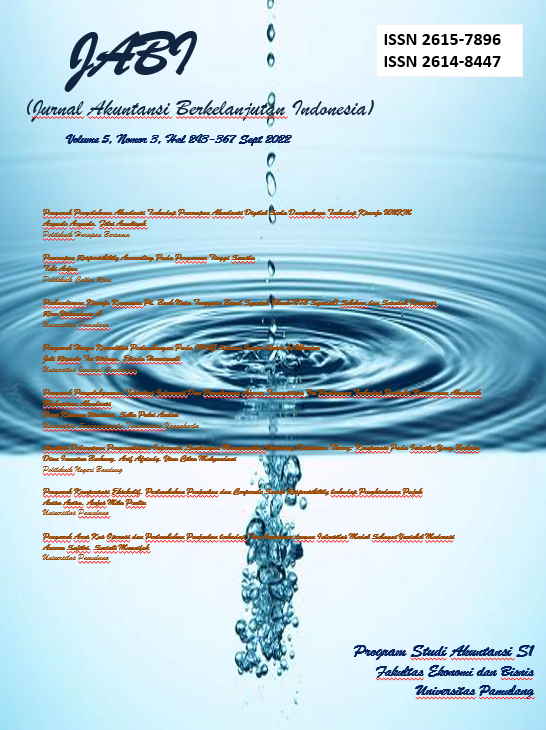Peran Modal Intelektual dalam Memoderasi Pengaruh Ambideksteritas Keuangan Terhadap Nilai Perusahaan LQ 45
DOI:
https://doi.org/10.32493/JABI.v8i1.y2025.p14-29Keywords:
Intellectual Capital; Financial Ambidexterity; Corporate ValueAbstract
This study explores the influence of intellectual capital as a moderator of the connection among financial ambidexterity and corporate value. The study focuses on corporates that have consistently been included in the LQ45 list on the Indonesia Stock Exchange (IDX) during the study period of year 2018 to 2023. A purposive sampling method was applied to choose 25 companies for the study. The study relies on secondary data gathered from the companies’ financial statement found on the IDX website.The analysis was performed using the SEM-PLS method with Warp-PLS 8.0 software, achieving a conviction level of 95%. The results reveal that intellectual capital serve as a moderating factor in the influence of financial ambidexterity, measured by asset growth, on corporate value. However, it does not act as a moderator for financial ambidexterity measured by sales growth and profit growth in relation to corporate value. Additionally, financial ambidexterity as measured by asset growth, is proven to affect corporate value, while it does not significantly influence corporate value when assessed through sales growth and profit growth.
References
Akbar, D. R., & Ardiyanto, M. D. (2021). Pengaruh Intellectual Capital Terhadap Kinerja Perusahaan Perbankan yang Terdaftar di Bursa Efek Indonesia. Diponegoro Journal of Accounting, 10(2), 107. https://doi.org/10.30742/economie.v1i2.1127
Barney, J. (1991). Firm Resource and Sustained Competitive Advantage. In Journal of Management (Vol. 17, Issue 24, pp. 231–247). https://doi.org/10.1080/713675936
Birger Wernerfelt. (1982). a Resource Based View of Thr Firm. In a Resource Based View of Thr Firm (p. 32).
Brookings A. (1996). Intellectual Capital - Core Asset for the Third Millenium Enterprise. Thomson Learning.
Chin, W. . (1998). The Partial least squares approach to structural equation modeling in G.A Marcoulides (Ed)Modern Methods for Business Research (1st ed., Vol. 1). Lawrence Erlbaum Associates.
Derbyshire, J. (2014). The impact of ambidexterity on enterprise performance: Evidence from 15 countries and 14 sectors James Derbyshire. The International Journal of Technological Innovation, Entrepreneurship and Technology Management, 34(10), 1–27.
Fu, N., Ma, Q., Bosak, J., & Flood, P. (2016). Intellectual capital and organizational ambidexterity in Chinese and Irish professional service firms. Journal of Organizational Effectiveness: People and Performance, 3(2), 94–114. https://doi.org/10.1108/JOEPP-03-2016-0021
Ghozali, I. (2013). Aplikasi Analisis Multivariate Dengan Program IBM SPSS 21 Update PLS Regresi.
Gunawan, H., & Tartila, R. (2017). Impact of intellectual capital on financial performance. Journal of Applied Managerial Accounting, 1(1), 359–365. https://doi.org/10.30871/jama.v1i1.1239
Harmono. (2016). Manajemen Keuangan Berbasis Balanced Scorecard Pendekatan Teori, Kasus, Dan Riset Bisnis (kesatu). Bumi Aksara.
Hermanto, O. H., & Triyonowati. (2023). Pengaruh Pertumbuhan Penjualan, Pertumbuhan Laba dan Likuiditas Terhadap Perusahaan Kosmetik dan Kebutuhan Rumah Tangga Yang Terdaftar di Bursa Efek Indonesia. 12.
Husna, R., & Rahayu, Y. (2020). Pengaruh Pertumbuhan Perusahaan, Kebijakan Deviden, Dan Profitabilitas Terhadap Nilai Perusahaan. Ilmu Dan Riset Akuntansi, 9 No.1. https://doi.org/10.33506/sl.v8i2.426
Iranmahd, M., Moeinaddin, M., Shahmoradi, N., & Heyrani, F. (2014). The effect of intellectual capital on institutional ownership and firm performance. International Journal of Academic Research in Accounting, Finance and Management Science, 4(2), 5–12. https://doi.org/10.6007/IJARAFMS/v4-i2/724
Lewis, M. W., Andriopoulos, C., & Smith, W. K. (2014). Paradoxical leadership to enable strategic agility. California Management Review, 56(3), 58–77. https://doi.org/10.1525/cmr.2014.56.3.58
Mulyanto, H., & Wulandari, A. (2019). Penelitian: Metode & Analisis. CV Agung.
Neha Smriti, N. Das. (2018). The impact of intellectual capital on firm performance : a study of Indian firms listed in COSPI. https://doi.org/10.1108/JIC-11-2017-0156
Nohria, Nitin, & Paul Lawrence. (1997). Ambidextrous Leadership: Managing for Innovation and Corporate Performance.
O Reilly, C. A., & Tushman, M. L. (1996). The Ambidextrous Financial Organization.
Pulić, A. (2008). The Principles of Intellectual Capital Efficiency - A Brief Description. Croatian Intellectual Capital Center, 76, 1–24. https://www.scinapse.io/papers/2371185822
Sabrina, S. (2015). Analysis of Intellectual Capital Effect Toward Financial Performance and Growth. Binus Business Review, 6(3), 449. https://doi.org/10.21512/bbr.v6i3.955
Stewart, T. A. (1997). “Intellectual Capital: The New Wealth of Organizations.” Doubleday.
Suryandari, N. N. A., Arie, A., & Wijaya, I. (2021). Faktor Profitabilitas, Kebijakan Hutang, Kebijakan Dividen, Keputusan Investasi Dan Ukuran Perusahaan Terhadap Nilai …. Jurnal AKSES, 13(2), 102–117. http://www.ojs.unr.ac.id/index.php/akses/article/view/778
Suryanto. (2017). KAJIAN EMPIRIS : PENGARUH MODAL INTELEKTUAL TERHADAP PERTUMBUHAN PERUSAHAAN DI INDONESIA. Jurnal Ilmiah Ilmu Administrasi, 9.
Syrifah, N. I., Wulandari, R., Ekonomi, F., Bisnis, D., & Pamulang, U. (2021). PENGARUH GOODWILL , INTELLECTUAL CAPITAL DAN PERTUMBUHAN PENJUALAN TERHADAP NILAI PASAR PERUSAHAAN SEKTOR BARANG Kata Kunci : Goodwill , Intellectual Capital , Pertumbuhan Penjualan , Nilai Pasar. Jurnal Riset Terapan Akuntansi, 7(1), 133–146.
Tan, H. P., Plowman, D., & Hancock, P. (2007). Intellectual capital and financial returns of companies. Journal of Intellectual Capital, 8(1), 76–95. https://doi.org/10.1108/14691930710715079
Triyani, W., Mahmudi, B., & Rosyid, A. (2018). Pengaruh Pertumbuhan Aset Terhadap Nilai Perusahaan Dengan Profitabilitas sebagai Variabel Intervening (Studi Empiris Perusahaan Sektor Pertambangan yang Terdaftar di Bursa Efek Indonesia Periode 2007-2016). 13(1).
Widhiastuti, S. (2023). Ambidexterity Keuangan (A. Sofatunisa (ed.)). Mega Press.
Downloads
Published
Issue
Section
License
Copyright (c) 2025 Rusfian, Susanti Widhiastuti

This work is licensed under a Creative Commons Attribution 4.0 International License.
Authors who publish with this journal agree to the following terms:
- Authors retain copyright and grant the journal right of first publication with the work simultaneously licensed under a Creative Commons Attribution License that allows others to share the work with an acknowledgement of the work's authorship and initial publication in this journal.
- Authors are able to enter into separate, additional contractual arrangements for the non-exclusive distribution of the journal's published version of the work (e.g., post it to an institutional repository or publish it in a book), with an acknowledgement of its initial publication in this journal.
- Authors are permitted and encouraged to post their work online (e.g., in institutional repositories or on their website) prior to and during the submission process, as it can lead to productive exchanges, as well as earlier and greater citation of published work (See The Effect of Open Access)

This work is licensed under a Creative Commons Attribution-ShareAlike 4.0 International License.

